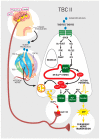Glucagon-Like Peptide 1 and Taste Perception: From Molecular Mechanisms to Potential Clinical Implications
- PMID: 33477478
- PMCID: PMC7830704
- DOI: 10.3390/ijms22020902
Glucagon-Like Peptide 1 and Taste Perception: From Molecular Mechanisms to Potential Clinical Implications
Abstract
Preclinical studies provided some important insights into the action of glucagon-like peptide 1 (GLP-1) in taste perception. This review examines the literature to uncover some molecular mechanisms and connections between GLP-1 and the gustatory coding. Local GLP-1 production in the taste bud cells, the expression of GLP-1 receptor on the adjacent nerves, a functional continuum in the perception of sweet chemicals from the gut to the tongue and an identification of GLP-1 induced signaling pathways in peripheral and central gustatory coding all strongly suggest that GLP-1 is involved in the taste perception, especially sweet. However, the impact of GLP-1 based therapies on gustatory coding in humans remains largely unaddressed. Based on the molecular background we encourage further exploration of the tongue as a new treatment target for GLP-1 receptor agonists in clinical studies. Given that pharmacological manipulation of gustatory coding may represent a new potential strategy against obesity and diabetes, the topic is of utmost clinical relevance.
Keywords: GLP-1; obesity; sweet; taste; tongue.
Conflict of interest statement
The authors declare that the current research was conducted in the absence of any commercial or financial relationships that could be construed as a potential conflict of interest. M.J. has no conflicts of interest. M.R. has given lectures, received honoraria and research support, and participated in conferences, advisory boards and clinical trials sponsored by many pharmaceutical companies including AstraZeneca, Boehringer Ingelheim, Kowa, Eli Lilly, Merck Sharp & Dohme, Novo Nordisk, Novartis, Roche Diagnostics, Sanofi and Servier; he is currently Medical Director, Novo Nordisk BA LM. A.J. has served as a consultant and is on speakers bureaus for AstraZeneca, Boehringer Ingelheim, Eli Lilly, MSD, Novo Nordisk, and Sanofi. None of the above had any role in this article, which has been written independently, without any financial or professional help, and reflects only the opinion of the authors, without any role of the industry.
Figures

Similar articles
-
Does intervention with GLP-1 receptor agonist semaglutide modulate perception of sweet taste in women with obesity: study protocol of a randomized, single-blinded, placebo-controlled clinical trial.Trials. 2021 Jul 19;22(1):464. doi: 10.1186/s13063-021-05442-y. Trials. 2021. PMID: 34281590 Free PMC article.
-
Glucagon-like peptide-1, a matter of taste?Rev Endocr Metab Disord. 2021 Dec;22(4):763-775. doi: 10.1007/s11154-020-09609-x. Epub 2020 Oct 29. Rev Endocr Metab Disord. 2021. PMID: 33123893 Review.
-
Glucagon-like peptide-1 is specifically involved in sweet taste transmission.FASEB J. 2015 Jun;29(6):2268-80. doi: 10.1096/fj.14-265355. Epub 2015 Feb 12. FASEB J. 2015. PMID: 25678625 Free PMC article.
-
Orosensory Detection of Dietary Fatty Acids Is Altered in CB₁R-/- Mice.Nutrients. 2018 Sep 21;10(10):1347. doi: 10.3390/nu10101347. Nutrients. 2018. PMID: 30241419 Free PMC article.
-
Intestinal glucagon-like peptide-1 effects on food intake: Physiological relevance and emerging mechanisms.Peptides. 2020 Sep;131:170342. doi: 10.1016/j.peptides.2020.170342. Epub 2020 Jun 6. Peptides. 2020. PMID: 32522585 Review.
Cited by
-
Does intervention with GLP-1 receptor agonist semaglutide modulate perception of sweet taste in women with obesity: study protocol of a randomized, single-blinded, placebo-controlled clinical trial.Trials. 2021 Jul 19;22(1):464. doi: 10.1186/s13063-021-05442-y. Trials. 2021. PMID: 34281590 Free PMC article.
-
Micronutrients in Pregnancy after Bariatric Surgery: A Narrative Review.J Clin Med. 2023 Aug 21;12(16):5429. doi: 10.3390/jcm12165429. J Clin Med. 2023. PMID: 37629473 Free PMC article. Review.
-
Tirzepatide suppresses palatable food intake by selectively reducing preference for fat in rodents.Diabetes Obes Metab. 2023 Jan;25(1):56-67. doi: 10.1111/dom.14843. Epub 2022 Sep 12. Diabetes Obes Metab. 2023. PMID: 36054312 Free PMC article.
-
Exogenous oral application of PYY and exendin-4 impacts upon taste-related behavior and taste perception in wild-type mice.Neuropharmacology. 2025 Jul 1;272:110408. doi: 10.1016/j.neuropharm.2025.110408. Epub 2025 Mar 12. Neuropharmacology. 2025. PMID: 40086622
-
The molecular signaling of exercise and obesity in the microbiota-gut-brain axis.Front Endocrinol (Lausanne). 2022 Jul 28;13:927170. doi: 10.3389/fendo.2022.927170. eCollection 2022. Front Endocrinol (Lausanne). 2022. PMID: 35966101 Free PMC article. Review.
References
Publication types
MeSH terms
Substances
LinkOut - more resources
Full Text Sources
Other Literature Sources
Medical

